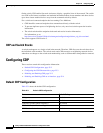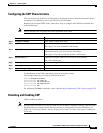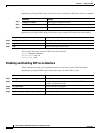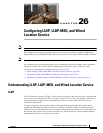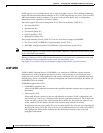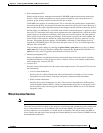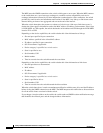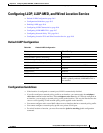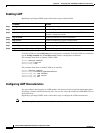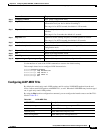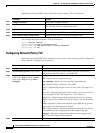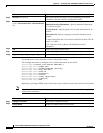
26-3
Catalyst 2960 and 2960-S Switch Software Configuration Guide
OL-8603-09
Chapter 26 Configuring LLDP, LLDP-MED, and Wired Location Service
Understanding LLDP, LLDP-MED, and Wired Location Service
• Power management TLV
Enables advanced power management between LLDP-MED endpoint and network connectivity
devices. Allows switches and phones to convey power information, such as how the device is
powered, power priority, and how much power the device needs.
LLDP-MED also supports an extended power TLV to advertise fine-grained power requirements,
end-point power priority, and end-point and network connectivity-device power status. However, it
does not provide for power negotiation between the endpoint and the network connectivity devices.
Starting with Cisco IOS Release 12.2(52)SE, when LLDP is enabled and power is applied to a port,
the power TLV determines the actual power requirement of the endpoint device so that the system
power budget can be adjusted accordingly. The switch processes the requests and either grants or
denies power based on the current power budget. If the request is granted, the switch updates the
power budget. If the request is denied, the switch turns off power to the port, generates a syslog
message, and updates the power budget. If LLDP-MED is disabled or if the endpoint does not
support the LLDP-MED power TLV, the initial allocation value (15.4 W) is used throughout the
duration of the connection.
You can change power settings by entering the power inline {auto [max max-wattage] | never |
static [max max-wattage]} interface configuration command. By default the PoE interface is in
auto mode; If no value is specified, the maximum is allowed (15.4 W).
• Inventory management TLV
Allows an endpoint to send detailed inventory information about itself to the switch, including
information hardware revision, firmware version, software version, serial number, manufacturer
name, model name, and asset ID TLV.
• Location TLV
Provides location information from the switch to the endpoint device. The location TLV can send
this information:
–
Civic location information
Provides the civic address information and postal information. Examples of civic location
information are street address, road name, and postal community name information.
–
ELIN location information
Provides the location information of a caller. The location is determined by the Emergency
location identifier number (ELIN), which is a phone number that routes an emergency call to
the local public safety answering point (PSAP) and which the PSAP can use to call back the
emergency caller.
Wired Location Service
Note To use wired location service, the switch must be running the LAN Base image.
The switch uses the wired location service feature to send location and attachment tracking information
for its connected devices to a Cisco Mobility Services Engine (MSE). The tracked device can be a
wireless endpoint, a wired endpoint, or a wired switch or controller. The switch notifies the MSE of
device link up and link down events through the Network Mobility Services Protocol (NMSP) location
and attachment notifications.




